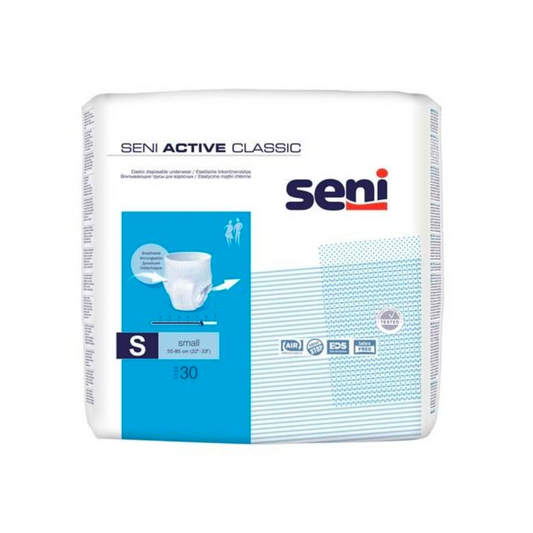
Food allergy - a warning signal of our body
Have you ever wondered if you suffer from a food allergy - or maybe it's just a food intolerance? What is the exact difference between the two? How can I clarify allergies by a doctor, and how does it succeed in maintaining the quality of life? We answer all of these questions in this article.
The food allergy day or "Day of Food Allergies" was launched in 2006 by the German Allergy and Asthmabund e.V. (DAAB). The DAB is a German organization that works for the concerns of people with allergies and asthma. The day is celebrated annually on June 21 and is intended to raise awareness of food allergies and their effects, as well as to inform those affected and their relatives about how to deal with food allergies. Overall, the following goals are forced:
Increase in consciousness
- Public awareness: Many people are not aware of the severity of food allergies. A special day helps to sensitize the general public and to raise awareness of the potentially life -threatening effects of food allergies.
- enlightenment: The day offers a platform to clarify the differences between food allergies and food intolerance and to explain the symptoms, diagnostic procedures and treatment options.
Support for those affected
- Resources and support: The day of food allergy can offer those affected and their families information about available resources, self -help groups and support networks.
- Empowerment: Through education and support, those affected feel better informed and can manage their allergies as autonomously as possible.
Promotion of research
- Research funding: Such a day can draw attention to the need for more research on the causes, prevention and treatment of food allergies. This can lead to better financing and support for research projects.
- Innovations in medicine: The promotion of research can develop new diagnostic methods and treatment approaches that improve the lives of people with food allergies.
Legal measures
- Food labeling: The day can be used to point out the importance of a clear and transparent labeling of food to ensure that people with food allergies can clearly recognize the ingredients.
Prevention of emergencies
- Emergency management: The day of food allergy can help to spread training and information about dealing with allergic emergencies. This includes the correct use of emergency medication such as adrenaline injectors.
- Safety measures: Schools, restaurants and public institutions can be informed about security measures that help minimize the risk of allergic reactions.
Strengthening the community
- Community formation: Events and activities related to the day of food allergy can bring people together who share similar experiences, which promotes exchange and mutual support.
- Promotion of inclusion: Through joint activities and public commitment, the understanding and acceptance of food allergies in society promotes.

What is the difference between food allergies and food intolerance?
While food allergies and food intolerances represent both reactions to foods, they differ fundamentally in their cause, their symptoms and their treatment. A correct understanding of these differences is important in order to take suitable measures for prevention and treatment.
Food allergies
- Caused: Food allergies are immunological reactions. The immune system incorrectly recognizes a certain protein in a food as a threat and produces antibodies (IGE) to combat it.
- Symptoms: Allergic reactions can include rashes, hives, swelling, breathing difficulties, gastrointestinal complaints and anaphylaxis. Symptoms usually occur quickly after eating the allergy -causing food.
- diagnosis: Diagnosed by skin tests, blood tests (specific IGE antibodies), elimination diets and oral provocation tests.
- Treatment: Avoidance of the triggering food, use of emergency medication such as adrenaline (epipen) in severe reactions, and antihistamines to relieve milder symptoms.
- risk: Can be life -threatening, especially in the case of anaphylaxis.
Food intolerance
- Caused: Food intolerances are usually not immunological. They arise from the digestion of certain food components, often due to a lack of certain enzymes.
- Symptoms: Symptoms can include flatulence, abdominal pain, diarrhea, nausea and headache. These often occur delayed, hours to days after consumption of the incompatible food.
- diagnosis: Diagnosed by anamnesis, elimination diets, specific tests such as the lactose intolerance test or the fructose breath test.
- Treatment: Avoiding or reducing the incompatible food, use of enzyme preparations (e.g. lactase for lactose intolerance).
- risk: Usually not life -threatening, but you can significantly impair the quality of life.
Comparison table
|
characteristic |
Food allergy |
Food intolerance |
|
Caused |
Immune reaction to a protein |
Problems with digestion, e.g. enzyme deficiency |
|
Symptoms |
Rashes, breathing difficulties, anaphylaxis |
Bloating, abdominal pain, diarrhea, nausea |
|
diagnosis |
Haut tests, blood tests, provocation tests |
Anamnesis, elimination diets, specific tests |
|
Treatment |
Avoidance, emergency medication, antihistamines |
Avoidance, enzyme preparations |
|
risk |
Can be life -threatening |
Usually not life -threatening |
|
Appearance |
Quick after consumption |
Delayed, hours to days after consumption |
|
mechanism |
Immunological mechanism (IGE-mediated) |
Non-immunological mechanism |
Examples
- Food allergy: A person who is allergic to peanuts can suffer hives, swelling or even anaphylactic shock immediately after eating peanuts.
- Food intolerance: A person with lactose intolerance has digestive problems such as flatulence and diarrhea after eating dairy products, since her body does not adequately produce the enzyme lactase to digest lactose.

Symptoms of a food allergy
Possible symptoms
Food allergies are immunological reactions of the body to certain proteins in food. These reactions occur when the immune system erroneously identifies a harmless protein as a threat and then produces antibodies. The next time you contact this allergen, the immune system triggers an allergic reaction that can cause a variety of symptoms, divided into different degrees of severity:
Slight symptoms:
- itching: Easy itching in the mouth, on the lips or throat.
- skin rash: Light skin reddening or urticaria (hives) with small, itchy whisper.
- Easy runny nose: Sneezing, clogged or running nose.
- Mild gastrointestinal complaints: Light abdominal pain, nausea.
Medium -heavy symptoms:
- Stronger skin reactions: Larger or intensive itchy urticaria, angioedema (swelling) on lips, eyes or face.
- Gastrointestinal complaints: Stronger abdominal pain, diarrhea, vomiting.
- Breathing difficulties: Light to moderate shortness of breath, coughing, gasping (bronchospasm).
- Cardiovascular symptoms: Light dizziness, faster or irregular heartbeat.
Severe symptoms (anaphylaxis):
- Strong shortness of breath: Difficulties in breathing, feeling tight in the chest, loud gasps.
- Swelling: Heavy angioedema, especially in the throat area that can make breathing difficult.
- Circuit problems: Strong drop in blood pressure, shock, lack of consciousness.
- Heavy vomiting and diarrhea: Fast fluid loss, which can lead to dehydration.
- Cardiac arrest: In extreme cases, cardiac arrest can occur.

Frequent allergens
Food allergies are triggered by an excessive reaction of the immune system to certain proteins in food. Some foods are often allergy -causing than others. Here are the most common food allergies and possible reasons for their frequency:
peanuts
- Peanut proteins are very stable and are not easily broken down by heat or digestive processes, which makes them more easily recognized by the immune system as a threat.
- The frequency of peanut allergies has increased in recent decades, which may be related to changed eating habits and the introduction of peanuts in early childhood.
Tree nuts (e.g. almonds, walnuts, hazelnuts)
- Similar to peanuts, tree nuts contain stable proteins that can trigger allergic reactions.
- The cross reactivity between different types of tree nuts can mean that people who are allergic to a kind of tree nut can also react to others.
milk
- Cow milk contains several proteins (e.g. casein, whey protein) that can cause allergic reactions.
- Milk allergies often occur in early childhood, with many children overcoming allergy to adulthood.
Egg
- The proteins in the protein, especially ovalbumin, are frequent allergens.
- Egg allergies mostly appear in childhood and many children grow out of this allergy.
Fish
- Fish contains heat stable proteins such as parvalbumin, which can also cause allergic reactions after cooking.
- Fish allergies are often serious and usually remain for a lifetime.
Shellfish (e.g. shrimps, crabs, lobsters)
- Shell animals contain tropomyosine, a protein that is strongly allergen and retains its allergens even after cooking.
- Cross reactions between different shellfish are common, which increases the risk of allergic reactions.
soy
- Soy contains several proteins that can trigger allergic reactions, such as Gly M 4.
- Soy -allergies often occur in children, but many overcome this allergy in adulthood.
Wheat
- Wheat contains many proteins (e.g. gluten, albumin, globulin) that can cause allergic reactions.
- Wheat allergies occur more often in children, but adults can also be affected.

Self -management in food allergies
Your own argument and dealing with a food allergy are a key factor in order to make the life of those affected more secure and more pleasant.
Enlightenment and knowledge:
- training: Participation in training and information events on food allergies.
- Sources of information: Use reliable sources, such as websites of the German Allergy and Asthmbeund (DAAB) or other allergy organizations.
Avoiding allergens:
- Read labels: Careful reading of food labels to avoid hidden allergens.
- Cooking and eating: Preferably cook yourself to keep control of the ingredients and ingredients. Ask in restaurants about a designated allergen list.
Emergency measures:
- Emergency set: Always a Emergency set with adrenaline autoinjector (epipen), antihistamines and, if necessary, carry corticosteroids and wound care.
- Swelling: Immediately wrap it Cooling pad On the affected body area. If the swelling is in the mouth or throat, sucking ice cubes or ice cream helps.
- Emergency plan: Have a clear emergency plan and share it with family members, friends and colleagues.
- training: Regular training in dealing with the adrenaline autoinjector and the emergency measures.
Nutritional adjustment:
- Nutritional advice: Support from a nutritionist to take advantage of a balanced diet despite allergy.
- Replacement products: Find and use suitable replacement products for allergy -causing foods.
Self -help groups and networks:
- Exchange: Participation in self-help groups or online forums to exchange experiences and tips with other affected people.
- Support: Search and offer social support from family and friends.

Medical treatment and care
Medical diagnostics with regular care form the basis for generating knowledge about allergies. Fixed contacts over a longer period of time are important to recognize changes in the state of health and be available for questions, transfers or also for adapting the treatment plan.
diagnosis:- Allergy tests: Implementation of skin prick tests, blood tests (e.g. IGE antibodies) and, if necessary, oral provocation tests by an allergist to the exact diagnosis.
- anamnese: Detailed survey of the medical history and symptoms by the doctor.
Treatment plan:
- Individual plan: Creation of an individual treatment plan based on the diagnosis and the specific needs of the patient.
- Medical therapy: Prescription of antihistamines, corticosteroids and adrenaline autoinjectors for emergency treatment.
Regular checks:
- surveillance: Regular control dates at allergists to monitor the course of the allergy and to adapt the treatment plan if necessary.
- Update of the emergency plan: Checking and updating the emergency plan if necessary.
Enlightenment and advice:
- Advice: Enlightenment about new findings and recommendations in dealing with food allergies.
- Risk -terminimization: Advice on risk minimization and the safe lifestyle with a food allergy.
Research and new therapies:
- Participation in studies: Possibility to participate in clinical studies or new therapeutic approaches, such as immunotherapy, to treat the allergy in the long term.
A well -coordinated interplay of self -management and medical care is crucial to minimize the risk of severe allergic reactions and to improve the quality of life of those affected.

Contributions and contact persons
In Germany there are several contact points and contacts for people who have to do with food allergies. These organizations and experts offer you support, information and advice:
German Allergy and Asthmabund e.V. (Daab)
- Description: The Daab is one of the leading organizations in Germany that deals with allergies and asthma. They offer extensive information, advice and support for those affected by food allergies.
Allergine formation services of the federal states
- Many federal states have their own information services or advice centers that offer specific information and support for allergies. One example is the "allergic information service Bavaria".
Specialists for allergology
- Description: Allergists are doctors who specialize in the diagnosis and treatment of allergies. You can carry out allergy tests and create individual treatment plans. Often general practitioners, ENT doctors or dermatologists have the additional designation as an allergist. So please inform yourself about your family doctor.
- Starting points: Transfers to an allergist can be made by general practitioners or pediatricians. Allergists are also available online, for example on websites of the associations of health insurance.
Nutritionist and dietician
- Description: Nutritional consultant and dietician with specialization in allergies and intolerances can help to develop a suitable diet and manage food allergies.
- Starting points: Nutritional advice can take place in clinics, private practices or through clubs such as the DAAB.
Self -help groups and forums
- Description: Self -help groups offer the opportunity to exchange ideas with other affected people and can offer valuable support and information.
- Starting points: Information on local self -help groups can be obtained via the DAAB or other allergy associations. Online forums and Facebook groups also offer platforms for an exchange of experiences.
Clinics with allergy centers
- Description: Some clinics and university clinics have specialized allergy centers that offer comprehensive diagnostic and therapeutic options.
These points of contact offer a wide range of services and support to help those affected by food allergies to manage their allergies and improve their quality of life.






























